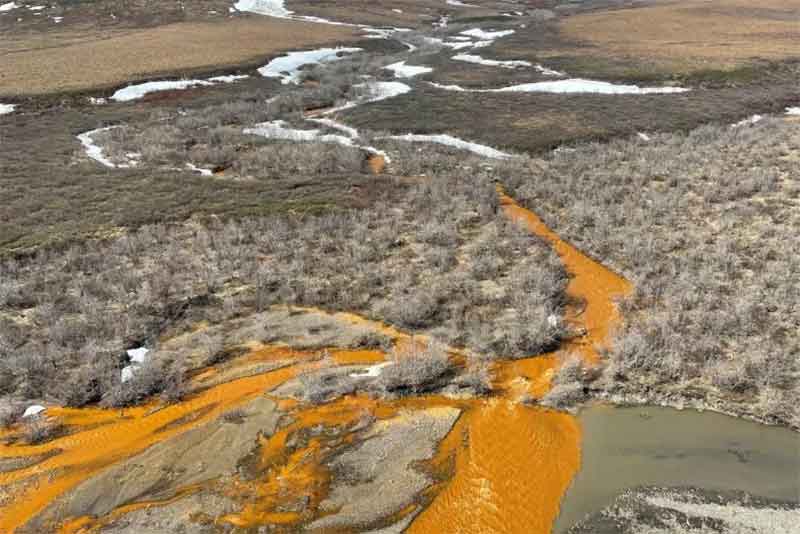
Global warming can add one more notch to its gun belt. The rapid onset of global warming is turning Alaska’s wilderness rivers orange. Global warming impacts Arctic temperatures 2-4 times warmer than the global average, and permafrost that’s been around since before humans sat round crackling cave fires is rapidly melting. Eons of frozen stuff is making its first appearance in tens of thousands of years, clobbering wilderness rivers with deadly toxicity.
Researchers believe the cause(s) is/are (1) acid from minerals leaching iron out of bedrock exposed to water for the first time in millennia and/or (2) bacteria mobilizing iron from the permafrost soil in thawing wetlands prompted by global warming.
A group of scientists at Alaska’s Kobuk Valley National Park reported numerous sightings of orange river water 60 miles from the nearest villages and 250 miles from road systems. Patrick Sullivan, an ecologist/University of Alaska, Anchorage, analyzed a screen of a sensor he had dipped into the water: “This is bad stuff.” (Source: Why Are Alaska‘s Rivers Turning Orange? Scientific American, January 1, 2024)
Dissolved oxygen in the orangish water was very low, the pH factor was 6.4 or 100 times more acidic than normal, and the electrical conductivity of the orange water was similar to industrial wastewater. Sullivan, stating the obvious: “Don’t drink this water,” Ibid. Honestly, think about the level of ridiculousness, it’s pristine (normally) drinkable water in the vast wilderness.
The scientists started their investigation of the water near the entry point of one of many streams to Salmon River that runs south from the peaks of Brooks Range, Alaska, known as “the last frontier,” which is a 650-mile line of slopes that separates northern Alaska from the rumbling Arctic coastline. A federal government act designated the Salmon River as a wild and scenic river with “water of exceptional clarity with deep luminescent blue-green pools and large runs of chum and pink salmon.” Sullivan: “It was a famous, pristine river ecosystem, and it feels like it’s completely collapsing now,” Ibid.
Ultimately, the Brooks Range rivers flow into the Arctic and Pacific Oceans.
Similar fate is discoloring rivers and streams throughout the Brooks Range. The researchers believe Russia and Canada are likely experiencing the same. Timothy Lyons, geochemist, University of California/Riverside said: “Almost certainly it is happening in other parts of the Arctic,” Ibid.
The scientists who studied the Range agree the major cause is climate change. For example, Kobuk Valley National Park has warmed by 2.4°C since 2006, and it’s believed the excessive heat has already begun thawing up to 40% of the permafrost. This is a good example of why global climate meetings, like COP28 recently held in Dubai, must come to grips with putting a stop to fossil fuel emissions, the number one agent on behalf of excessively harmful global warming.
The Brooks Range group of scientists conducted the first ever comprehensive sampling of an entire watershed on a six-day mission down the Salmon River. They believe a combination of (1) acid from minerals leaching iron out of bedrock exposed to water for the first time in millennia and/or (2) bacteria mobilizing iron from the permafrost soil in thawing wetlands is/are behind the dirty deeds, which means rusting will gradually “smother streams almost anywhere there’s permafrost,” inclusive of one-fourth of the entire Northern Hemisphere. This is a prime example of how far-reaching excessive global warming destroys the most pristine ecosystems on the planet and speaks to the necessity of halting fossil fuel emissions, yesterday. After all, this is what happens at 2°C above pre-industrial, ecosystems collapse. Only recently, Dr. James Hansen/Columbia University shocked science by saying 2°C will arrive during the 2030s, way-way earlier than IPCC projections.
Traversing the river, they found murky water over orange rocks where only a couple of years ago it was clear and full of fish, not now. At some spots the water ran half orange and half green and at others further downstream the river had the color and opacity of pea soup. Forrest McCarthy, a former US Antarctic Program coordinator, claimed: “Most climate change is subtle. This is like, bam!” Scientists claim they could not find any fish or insects in some areas of the Range, stating: “Biodiversity just crashed,” Ibid.
Meanwhile, 50 miles west of Salmon, the Agashashok River also turned orange-brown. Sullivan and company expressed shock by how fast streams started transforming, e.g., Clear Creek water was so acidic that it curdled the powered milk used for nightly tea, as the scientists traversed the Range.
On a trip to Timber Creek, 20 miles west of Salmon River, one of the members of the team who had fly-fished in the creek a few years ago, discovered: “More iron than fish… I looked at the creek, and I said, ‘this creek is dead. It’s just blanketed with metals,” Ibid. It’s what’s found in a national park, in the wilderness, don’t think about it too much, it’s deadly.
Additionally, the team discovered several blackened, dark ground patches the color of fresh asphalt scattered throughout the Range. At one patch they took a sample of the trickling water flowing out of a dark patch. It had a pH factor of 2.95, like vinegar. The ground burn was caused by acid, and according to the team: “If it’s got that low of a pH… it’s actively burning. There’s at least a dozen burns in this valley,” Ibid.
Brooks Range, Alaska is a preeminent example of how global warming enhanced by, driven by, fossil fuel emissions from cars, trains, and planes and industry impacts the most precious ecosystems of the planet where nobody lives but where life is supposed to thrive. It isn’t thriving any longer. Only an international forum like the UN climate change conferences held yearly, called COP, can come close to fixing this open sore on the planet, maybe?
Robert Hunziker is a journalist from Los Angeles













































